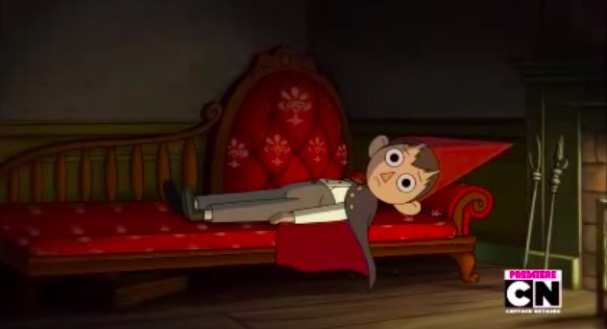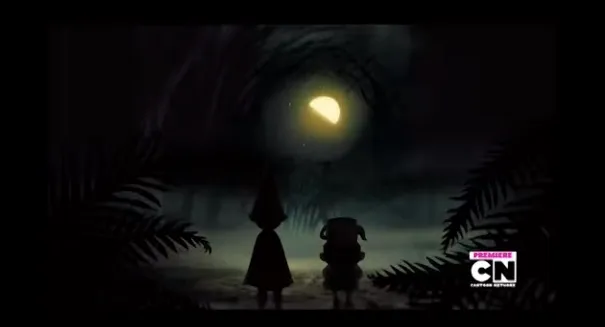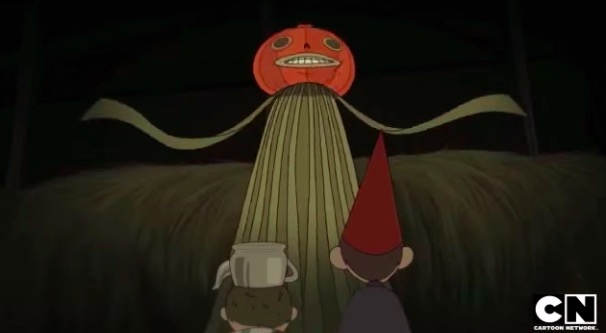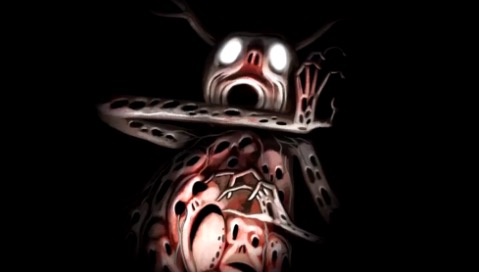While it’ll be some time before we can start weaving the history books, I’m fairly prepared to say we’re currently living in a new Golden Age of western animation. Starting as early as the controlled, beautiful storytelling of Avatar and exploding in the wake of Adventure Time’s bold exploration of worldbuilding and mythos, we’ve finally reached a point where the gatekeepers of entertainment are ready to consider animation, if not as seriously as supposed “real” entertainment, as a flexible field of possibilities. Most recently, that means Over the Garden Wall, perhaps Cartoon Network’s first true miniseries since Tartakovsky’s Clone Wars was regrettably swept under the rug.
One thing the recent generation of cartoons has had in common, from Legend of Korra to Gravity Falls, is a willingness to cast a wider net through the maturity of its writing. A lot of this stems from the 90s, with its envelope-pushing oddities (Invader Zim, Courage the Cowardly Dog), influx of anime (all the way up to today, when Space Dandy aired in America before Japan), and the burgeoning heyday of explicitly teen and adult oriented cartoons (Daria, the birth of Adult Swim).
And as those who came of age in the late 80s and 90s come to creative positions of power, the realization starts to assert itself that the appeal of animation isn’t down to an age demographic. The exploration of what that might mean is what we’re in the midst of now, and so we come back to that miniseries. Over the Garden Wall is an experiment with one foot in history and one in the now, trying its hardest to act as a fairytale for the millennial generation.
Now, OtGW has its hand in quite a few pots as far as thematic exploration, so we’re going to break it down subheading style. And because this show is well worth watching, and richer for going in without prior knowledge, I will now warn for copious spoilers.
The Old Façade of New Heroes, and Vice Versa
At first glance, there’s quite a muddy aesthetic going on in OtGW: both Wirt and Greg are wearing 19th century Germanic clothing, speaking like modern Americans but without any of the accompanying technology (which later still we find is only as current as cassette tapes and house phones—fitting enough, since the millennial generation begins in the 80s), and Wirt lays himself down for a couch therapy session like a regular Woody Allen (though perhaps that reference can now be better filled by Hannah or any of the myriad mumblecore protagonists of the modern age).
But it’s not so much carelessness as a deliberate attempt to put us in the mindset of what it means to be of the “millennial” generation, both glutted with more technological and communicative advancement than any other time period and caught up in the trappings of the past—from the aesthetics of the hipster generation (it would be unkind if not unfair to crush this gem beneath the label of “twee,” but there certainly are a number of well-waxed moustaches) to the resurging echoes of the civil rights era.

If Girls has taught me anything, it’s “fail to acknowledge your issues and seek out emotionally meaningless”—you know, I don’t think that applies here.
Which leads us to consider Wirt, a young man caught between child and adult, as a protagonist. Wirt’s very design is misleading—whether because of his round face and anachronistic clothes or simply a solid reference point, it’s something of a shock to hear that Wirt’s in high school. In fact, the narrative almost goes out of its way to obscure this with the “young lover” scene in the tavern (which ends on the lyric “when little boys get married”).
On the one hand, it’s something of a nudge at the precocious crushes that litter the TV landscape, where writers find themselves hamstrung between marketable tween protagonists and that sweet, sweet romantic trope box-checking (the problem being less that real kids that age aren’t wrestling with romantic and possibly sexual feelings and more that their TV counterparts are written with an aggressive unwillingness to acknowledge those frustrations in the name of molding tiny adults).
On the other hand, it forces us to divorce age from the concept of maturity. It’s a common lowball lobbed at millennials that they don’t become adults but rather taller children. And Wirt is immature: that couch introspection I mentioned lacks any actual introspecting, indulging in how rejected he feels rather than, say, his self-isolating tendencies or general passivity. In the “real” world, he’s so fixated on painting himself as the “nice guy” who had the girl swept away from him that he turns blinders on to Sara’s fairly evident (for teenagers) desire to get closer.
Wirt isn’t a bad person, but he’s self-focused without being self-aware, wanting to shape a narrative around himself but unwilling to make the necessarily proactive movements (and speaking of inventing narratives, there’s a whole other essay to be written about Wirt, Beatrice, and those scissors). But at the same time, the story isn’t about Wirt Growing Up … at least, not in the way one would expect. After all, the adults have troubles of their own.
The Landscape of the Unknown
I’ve been somewhat beaten to the punch on the basics here: this post gives a good rundown of the Unknown as a semi-real, purgatorial kind of landscape that both exists in its own right and also reflects the brothers’ oscillation between life and death: the half-full moon, the autumnal season shifting into winter, and so on. It’s very explicitly a stage of transition, wandering and wanting. All the characters Wirt and Greg meet are missing something, be it a memory, an item, or another being. And at the same time, each place that the brothers visit is a potential “final” resting place that they reject in their quest to return home.
While there’s very little on the nose depiction (indeed, I’d wager to say at least some of it is unintentional but no less applicable), each place draws from varies afterlife mythos or religious traditions. Pottsfield, led by the rumbling patriarchal voice of Enoch, evokes Judaism—our heroes’ punishment is temporary (as there’s not really an “eternal damnation” in Jewish belief), and the skeletal bodies of Pottsfield’s residents lay waiting in the ground until their leader enlists someone to resurrect them.
The schoolhouse has echoes of Buddhism, with its attempts to spread enlightenment through knowledge, its patron shedding great wealth after having been so impressed by the realization of this enlightenment, and the rejection of pleasure of the worldly (simple mashed potatoes). The tavern has traces of Egyptian mythology, wherein visitors are measured by their actions (hence the enormous pressure to choose a “role” that defines oneself) and the danger of being consumed by a Beast if one is rejected. Endicott’s mansion is the earthly stasis of ghosts, unaware of oneself, others, or even the facts of one’s own existence—still surrounded, in theory, by one’s desires but simultaneously trapped by them.
The ferry quite strongly evokes the passage across the river Styx from Greek mythology, which also required payment or trickery to get from one side to the other in one piece. Adelaide’s house is the Atheist conception of death—the complete expunging of the soul or self upon arrival, while one’s body becomes a fuel for those still living. Auntie Whispers’ house harkens to the Puritanical sects, which were all about expunging evil through constant labor and sacrifice.
And, of course, Greg takes a trip to the fluffy cloud Christian Heaven that serves as such a popular conception for … well, for children. And most frightening of all is the living death of the Beast’s offer, who stands watch not so much as a Satan figure as the terror of a life unlived. The woods, surrounding each of these end points and becoming most threatening when a wanderer loses hope (through internal or external means), make an apt metaphor for the aimlessness that comes with young adulthood, and the serious impacts of depression.
Who Are You?
Much is made of roles and desires, explicitly and implicitly, throughout the story. The highlight, of course, is the tavern scene: the regulars are insistent that Wirt have a title for himself (Greg, being young, is exempt from this pressure), are immediately distrustful of him when he doesn’t have one, and go so far as to ascribe him a name in the end. They don’t even stop there—with the name comes a whole narrative of what they know that name to mean, and how it dictates the future of Wirt’s life. And it’s not even malicious in intent, since that is what worked for their own pasts. They’re trying to pass down what they believe to be the wisdom of their generation without realizing that it doesn’t fit the “now” of Wirt’s situation, and they nearly leave him the worse off for it.
The adults of OtGW are complicated things. Coming of age stories are often content to pit the old generation against the new one, giving the latter the opportunity to teach the former about how they’ll change things for the better. And there are elements of that here, in both the tavern and the Woodsman’s story. But it’s all tangled up in good intentions and glimmers of truly good advice. We’ve learned long before the end of the series that the lantern IS the Beast, that the woods are a dangerous place, and that there’s something dangerous about Lorna. These are true, helpful bits of advice … but they’re tangled up in obfuscation, unmentioned details, and the fears of the teller.
A lack of communication on both sides is often the cause of danger and complication—the adults refuse to explain things to our protagonists, choosing to scare them instead (often because they’re trying to hide their own fear or shame of past actions). At the same time, Wirt’s first instinct is scorn or distrust of the adults they come across, even the ones who aren’t actively malicious, leading him to wholly reject both the good and the bad of their statements. Neither side is presented as wholly right, and it’s most often a combination of the two—the adults’ lived experience and Wirt and Greg’s idealistic, fresh approach to old problems that leads to a solution.
But that leaves the question posed before, of who Wirt (and thus, a millennial) might be. It’s not that he gains the confidence to Win the Girl, though in the hospital he finally seems ready to meet her halfway. But that’s not what it’s about—Wirt’s tale is about action versus inaction, and failing to repeat the sins of the past. The Woodsman is pushed by grief and fear into doing evil things (though his conversation with the Beast about the edelwood hints that he would indeed have been willing to knowingly benefit from others’ suffering to protect himself and his “daughter”). The Woodsman isn’t evil, but he is blind to suffering outside his own, unable to break the cycle himself.
It’s crucial, then, that Wirt be offered the same fear and the same choice, so that we can observe the present generation—the millennials who’ve been called aimless and self-centered and childish—intuit what must change. Wirt’s realization is of his responsibility to others, and it has two stages. The first is his protectiveness of Greg, and his willingness to disregard his own wants to save a loved one. But that’s not enough—the Woodsman already did that. Wirt must also reject the lantern and its representation of the continued crushing and exploiting of others, strangers or no, to maintain his own position.
It’s not that he rejects Greg, but that he sees through to the falseness of the choice. It isn’t “feed the lantern or lose Greg,” it’s “feed the lantern or this corrosive system (revealed as a mass of screaming, horrified faces) cannot survive.” And Wirt is able to throw that hierarchy of humanity away, or recognize that he should—and thus finds his way out of that aimless wandering. He’s not suddenly a perfect human being, but he’s stumbled on a truth that can not only shape the future but inform the past—the Woodsman’s final act (not including the epilogue) is to blow out the lantern himself, tearing down the cycle he hated but couldn’t see a way out of before.
And so we come back around to the question of “who am I,” in an uncertain time and generation. To the mocking of SJWs and Twitter activism and the teeming of protests on the streets in untold numbers. There is much yet that millennials don’t know about themselves, but we’re coming to know what we can do and say—that it’s not about shaping roles for ourselves or walking in comparison to old footsteps but about caring for the wellbeing of others, for seeing through established systems of violence and oppression and taking the first steps to finding a new way forward. Imperfectly, uncertainly, but with admirable passion and new insight.
Want to share this on Tumblr? There’s a post for that!
Vrai is a queer author and pop culture blogger; there is a hole in their physical media collection yearning for a Blu-Ray release of this series. You can read more essays and find out about their fiction at Fashionable Tinfoil Accessories, support their work via Patreon or PayPal, or remind them of the existence of Tweets.
—Please make note of The Mary Sue’s general comment policy.—
Do you follow The Mary Sue on Twitter, Facebook, Tumblr, Pinterest, & Google +?











Published: Jun 24, 2015 08:00 pm